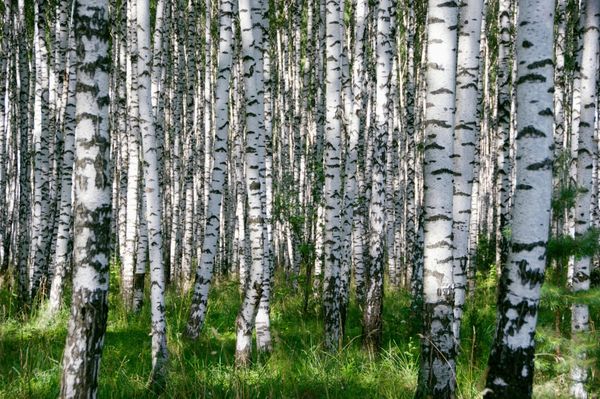Birch Tree
Birch Tree
Chicagoland's Top Rated Local® Tree Services

Birch Tree
The birch tree is a thin-leaved, short-lived hardwood tree known for its smooth, resinous, grayish-white bark marked by horizontal pores known as lenticels. Because birch bark peels easily, it has been used throughout history as the basis of many papers and handicrafts. Birch trees are native to northern temperate and boreal climates, including the Chicago area. There are about 40 species of birch tree, including 15 species native to the United States. Of the 15 species of birch trees native to the United States, about half can be found in Chicagoland. Birches make an attractive addition to any backyard or garden, thanks to their satin-like sheen and pale color.
- Botanical Name: Betula
- Family (English): Birch
- Family (Botanic): Betulacea
- Leaf Retention: Deciduous
- Soil Tolerances: Acidic, loamy, moist
- Flowering Date: Late spring
- Height: Max. 70 feet
- Width: Max. 60 feet
Species of Birch Trees Common in Chicagoland
Yellow Birch (Betula alleghaniensis) – Also known as the golden birch, yellow birches are named for their bronze bark.
Paper Birch (Betula papyrifera) – Native to the Chicago area, paper birches are known for their white, paper-like bark.
Sweet Birch (Betula lenta) – Also known as the cherry birch, sweet birches have reddish brown bark with white lenticels.
Gray Birch (Betula populifolia) – Named for its whitish gray bark, gray birches’ foliage is green in summer but changes to a vibrant yellow come fall, making it an especially beautiful species.
River Birch (Betula nigra) – Also known as the black birch or water birch, river birches grow in wet areas such as swamps and floodplains. River birch bark changes color significantly as the tree matures, starting out as pinkish gray and becoming a reddish brown.
Common Birch Diseases
Birch canker – Birch canker is caused by a fungus, and results in sunken areas of dead tissue on the tree’s trunk or branches. Birch canker sores are dark and covered with a sticky sap. Branches affected by birch canker must be trimmed immediately to prevent the spread of the disease. Our team of professionals at J & S Tree Service in Chicago are happy to trim your birch tree’s branches in order to combat this devastating affliction.
Leaf scorch – Defined as a browning of plant tissues, this non-infectious condition is caused by environmental factors rather than a virus, bacteria, or fungus. Favorable weather conditions include high temperatures, low winds, and low soil moisture. Affected leaves will begin to turn yellow on the edges, eventually becoming brown and withered. Our tree service experts at J & S Tree Service in Chicago can help combat your birch tree’s leaf scorch by applying extra mulch, fertilizer, and watering during dry weather conditions.
Heart rot – Heart rot is a fungal disease that attacks the inside of the tree, leading to wood decay. Common symptoms of the disease include mushroom-like fungi that form on the trunk. However, as it is the inside of the trunk that is most affected, a tree may appear healthy but still be suffering from heart rot.
As there is no effective treatment for heart rot, prevention is key. The best way to prevent this fungal disease from affecting your birch trees is to hire a professional tree pruning service, such as J & S Tree Service in Chicago. We will help remove damaged and broken branches that could allow access to heart rotting fungus. Contact us today to learn more.
Common Birch Pests
Bronze birch borer – The most lethal birch pest, the bronze birch borer, lay their eggs on birch bark, causing their larvae to bore inside the trunk and feed on the sapwood inside. Bronze birch borers can be identified by their slender shape and bronze color. Their larvae are also slender, but segmented and white in color. Bronze birch borers can kill a birch tree, so prevention, such as summer insecticide treatment, is essential.
Birch leafminer – Birch leafminers are small sawflies closely related to bees or wasps. They can be identified by their fly-like appearance. Birch leafminers’ larvae are yellowish white and legless. Birch leafminers attack trees by laying eggs on leaves, which their larvae then eat from the inside out. Leaves affected by birch leafminers will have greenish brown spots. While these pests are rarely lethal to the tree, they can cause significant damage.
Birch aphids – Birch aphids are small green pests that feed on birch sap. Affected leaves can be identified by their yellow color and disfigured shape, and they may be coated in a sticky aphid secretion known as honeydew.
Chicagoland Tree Services
J & S Tree Service is here for all your Chicagoland tree service needs, including birch disease and pest treatment or prevention. We are bonded, licensed, and fully insured, so you can feel confident that you are in good hands. J & S Tree Service specializes in tree removal, tree trimming, stump removal, storm damage cleanup, and commercial tree removal. Get in touch today for a free estimate.
